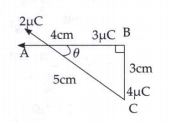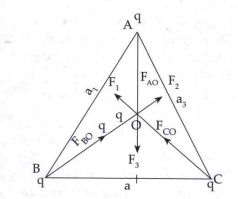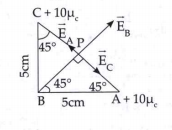Complete Solutions to EXERCISE of chapter ELECTROSTATICS of Class 11 book with complete answers and questions
| Class 11 | PHYSICS |
| Chapter | ELECTROSTATICS |
| CHETANA PUBLICATION | EXERCISE |
| Number Of Questions | 100 |
| Academic Year | 2023-24 |
What is the basic difference between electrostatics and current electricity?
View SolutionGive two examples of electric charges developed due to friction.
View SolutionName the different elementary particles of a matter?
View SolutionExplain Most matter around us is electrically neutral.
View SolutionExplain the process of charging by conduction with suitable example.
View SolutionWhat do you mean by induction in electrostatics? How can we charge a conductor by induction?
View SolutionDistinguish between additive property of charge and additive property of mass.
View SolutionWhat is the magnitude of charge on an electron?
View SolutionWhat are quarks?
View SolutionExplain quantization of charge.
View SolutionHow much positive and negative charge is present in lgm of water? How many electrons are present in it? Given, molecular mass of water is 18.0 g.
View SolutionState the law of conservation of charge.
View SolutionName the types of force experienced by charged objects when they are brought close to each other.
View SolutionWhich type of force do like charges exert on each other?
View SolutionWhich type of force do unlike charges exert on each other?
View SolutionName the fundamental law governing interaction between charges on any body
View SolutionWhat is a point charge?
View SolutionState Coulomb's law and write it in scalar form.
View SolutionDefine relative permittivity
OR
what is relative permittivity?
OR
Define dielectric constant of medium.
OR
Define specific inductive capacity.
View SolutionDefine unit of charge from Coulomb's law.
View SolutionCharge on an electron is `1.6 xx 10^-19`. How many electrons are required to accumulate a charge of one coulomb?
View SolutionExpress Coulomb's law in vector form.
View SolutionState the similarities between gravitational and electrostatic forces.
View SolutionDistinguish between gravitational force and electrostatic force
View SolutionCalculate and compare the electrostatic and gravitational forces between two protons which are `10^-15` m apart. Value of `G = 6.674 xx 10^-11 Nm^2//kg^2` and mass of the proton is `1.67 xx 10^-27kg.
View Solution(i)Two small spheres 18 cm apart have equal negative charges and repel each other with the force of `6 xx 10^-8` N. Find the total charge on both spheres
View Solution(ii)A charge `+q` exerts a force of magnitude `-0.2`N on another change `-2q`. If they are separated by 25..0 cm, determine the value of q.
View SolutionState and explain the principle of superposition of interacting charges.
View SolutionThree charges of `2muC, 3 mu C` and `4 mu C` are placed at points A, B and C respectively, as shown in Fig. a Determine the force on A due to other charges.

View SolutionThree equal charges of `10 xx 10^-8` C respectively, each located at the comers of a right triangle whose sides are 15cm, 20cm and 25cm respectively. Find the force exerted on the charge located at `90^@` angle.
View SolutionThree charges, q each, are placed at the vertices of an equilateral triangle. What will be the resultant force on charges Q placed at the centroid of the triangle?

View SolutionFour charges of `+ 6 x 10^-8`C each are placed at the comers of a square whose sides are 3cm each. Calculate the resultant force on each charge and shows in direction an a diagram drawn to scale.

View SolutionWhat is a test charge ?
View SolutionWhat will happen if a test charge is kept beyond the electric field due to a certain charge?
View SolutionDefine electric field write its formula vector form.
View SolutionDerive the dimension eleic field state its unit.
View SolutionExplain the uniform electric field and non uniform electric field with suitable diagram
View SolutionDerive an expression for electric field intensity due to a point charge in a material medium.
View SolutionCalculate the electric field due to a charge of `-8.0 xx 10^-8` C at a distance of 5.0 cm from it
View SolutionDefine electric potential.
View SolutionDefine potential gradient and state its units and formula.
View SolutionDerive the relation between electric field intensity and electric potential
OR
show that `E = frac(-dv)(dx)`
View SolutionTwo charge `5 mu C` and `- 4 mu C` are kept 5.0 m apart at points A and B respectively. How much work will have to be done to move the charge at A through a distance of 5.0 m further away from point B along the line BA
View SolutionA potential difference of 5000 volt is applied between two parallel plates 5cm apart a small oil drop having a charge of `9.6 xx 10^-19 C` falls between the plates. Find (a) electric field intensity between the plates and (b) the force on the oil drop.
View SolutionGap between two electrodes of the spark-plug used in an automobile engine is 1.25 mm. If the potential of 20 V is applied across the gap, what will be the magnitude of electric field between the electrodes?
View SolutionThree point charges are placed at the vertices of a right isosceles triangle as shown in the Fig. a. What is the magnitude and direction of the resultant electric field at point P which is the mid point of its hypotenuse?


View SolutionA simplified model of hydrogen atom consists of an electron revolving about a proton at a distance of `5.3 xx 10^-1` 1m. The charge on a proton is `+1.6 xx 10^-19` C. Calculate the intensity of the electric field due to proton at this distance.
View SolutionWhat is the electric of force?
View SolutionDiagrams of lines force.
View SolutionLines of force are imaginary, can they have any practical use?
View SolutionState the characteristics of lines of force.
View SolutionIf two lines of force interest on one point, what does it mean?
View SolutionDefine electric flux state its formula and units.
View SolutionDerive an expression for the electric flux passing through a given area.
View SolutionState conditions in which electric flux will be maximum and minimum.
View SolutionThe electric field in a region is given by `vecE = 5.0 N//C`. Calculate the electric flux Through a square of side 10.0 cm in the following cases:
(i) The square is along the XY plane.
View SolutionThe electric field in a region is given by `vecE = 5.0 N//C`. Calculate the electric flux Through a square of side 10.0 cm in the following cases:
(ii) The square is along XZ plane.
View SolutionThe electric field in a region is given by `vecE = 5.0 N//C`. Calculate the electric flux Through a square of side 10.1 cm in the following cases:
(iii) The normal to the square makes an angle of `45^@` with the Z axis.
View SolutionState Gaus's law.
View SolutionShow that the total flux passing through a sphere is independent of the radius of sphere.
View SolutionState and prove Gauss' law in electrostatics. Define.
View SolutionDefine electric dipole.
View SolutionWhat is the called dipole axis?
View SolutionWhat is called axial line of dipole?
View SolutionWhat is called equatorial line of dipole?
View SolutionHow do we measure strength of a dipole?
View SolutionDefine dipole moment of electric dipole.
View SolutionWrite the expression for dipole moment in vector form
View SolutionState the unit of dipole moment of electric dipole.
View SolutionState the dimension of dipole moment.
View SolutionHow can we induce a dipole in non polar molecules ?
View SolutionDistinguish between polar molecules and non-polar molecules
View SolutionDerive the expression for the couple acting on the electric dipole in uniform electric field
View SolutionDerive the expression for electric intensity at a point on the axis of a dipole
View SolutionDerive an expression for electric field intensity of a point on the equatorial line.
View SolutionDefine Linear charge density. State its formula and units.
View SolutionDefine Surface charge density. State its formula and unit.
View SolutionDefine Volume charge density. State its formula and units.
View SolutionGive suitable examples showing that static charge can be useful.
View SolutionGive suitable examples showing that static charge can be harmful.
View SolutionMention the precautions to be taken against static charge.
View SolutionTwo point charges, each of `4 mu C` when placed in vacuum, repel each other with a force of 1.6 Newton. Calculate the distance between the two charges.
View SolutionFind the value of the electric intensity at a point at a distance of 15 cm in air from a point charge of 450 `muC`.
View SolutionHow many electrons need be removed from a metal sphere of 0.05 m radius so that it acquires a charge of `4 xx 10^-15` C ? `e = 1.6 xx 10^-19` C.
View SolutionWhat charge placed 9 cm from a charge of `100 muC` will produce a force of `1//9` N in air?
View SolutionTwo point charges whose magnitudes are in the ratio `3 : 2` repel each other with a force `135 xx 10^14` N when they are 4 cm apart in air. Find the magnitude of each charge.
View SolutionTwo small insulated metal spheres placed 5 cm apart in air carry charges of 5 and 0.5 micro- coulomb respectively. Find the force between them. What would the force be if the spheres are in a medium of dielectric constant 3?
View SolutionThe mutual force of repulsion between two point charges kept a fixed distance apart is `9 xx 10^-5` N when in vacuum and `4 xx 10^-5` N when placed in a dielectric medium. What is the value of dielectric constant of the medium?
View SolutionThe force exerted by an electric field on a charge of 5 micro-coulomb is `10 xx 10^-4` N. What is the electric intensity of the field at the point?
View SolutionThe potential at a point A is -160 volt and the potential at a point B is + 240 volt. How much work is done by an external force to move a charge of `-25 mu C` from B to A?
View SolutionTwo positive charges of `20 mu C` and `8 mu C` are 20 cm apart, find the work done in bringing them 5 cm closer
View SolutionThree Charge of +10, -10 and `+ 5 mu C` are placed at the corners A, B and C of an equilateral triangle ABC having each side 1m long. Find the resultant force on the charge at C.
View SolutionA positively charged glass rod is brought close to a metallic rod isolated from ground, the charge on the side of the metallic rod away from the glass rod will be____
A. same as that on the glass rod and equal in quantity
B. opposite to that on the glass of and equal in quantity
C. same as that on the glass rod but lesser in quantity
D. same as that on the glass rod but more in quantity
View SolutionAn electron is placed between two parallel plates connected to a battery. If the battery is switched on, the electron will
View SolutionA charge of `+ 7 mu C` is placed at the centre of two concentric spheres with radius 2.0 cm and 4.0 cm respectively. The ratio of the flux through them will be.
View SolutionTwo charges of 1.0 C each are placed one meter apart in free space.The force between them will be.
View SolutionTwo point charges of `+ 5 mu C` are so placed that they experience a force of `8 xx 10^-3` N. They are then moved apart, so that the force is now `2 xx 10^-3` N. The distance between them is now
View SolutionA metallic sphere A isolated from ground is charged to `+ 50 mu C`. This sphere is brought in contact with other isolated metallics sphere B of half the radius of sphere A.The charge on the two sphere will be now in the ratio.
View SolutionWhich of the following produces uniform electric field?
View SolutionTwo point charges of `A = + 5.0 mu C` and `B = -5.0 mu C` are separated by 5.0 cm. A point charge `C = 1.0 mu C` is placed at 3.0 cm away from the centre on the perpendicular bisector of the line joining the two point charges. The charge at C will experience a force directed towards
A. point A
B. point B
C. a direction parallel to line AB
D. a direction along the perpendicular bisector
View Solution
EXERCISE questions and complete solutions for chapter ELECTROSTATICS of CHETANA PHYSICS (MARATHI ENGLISH) of Class 11